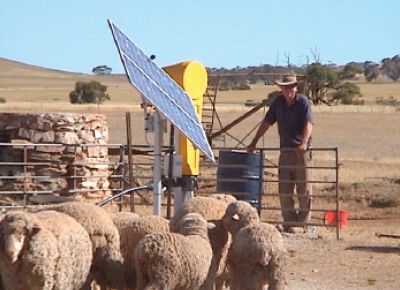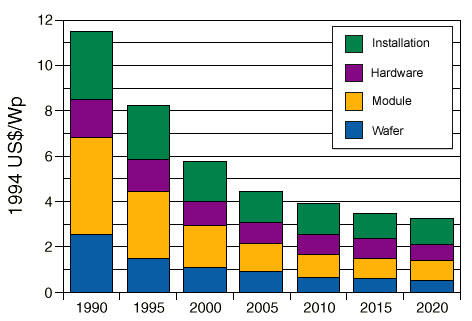Solar Powered Water Pump
There are more than 10,000 solar powered water pumping in use in the world today. They are widely used on farms and outback stations in Australia to supply water to livestock. In developing countries they are used extensively to pump water from wells and rivers to villages for domestic consumption and irrigation of crops. A typical PV-powered pumping system consists of a PV array that powers an electric motor, which drives a pump. The water is often pumped from the ground or stream into a storage tank that provides a gravity feed. No energy storage is needed for these systems. PV powered pumping systems are widely available from agricultural equipment suppliers and they are a cost-effective alternative to agricultural wind turbines for remote area water supply.

Figure 1
Solar powered water pumping in rural Australia. (courtesy of the IEA Photovoltaic Power Systems Program).
Benefits
Photovoltaic (PV) systems are used to pump water for livestock, plants or humans. Since the need for water is greatest on hot sunny days the technology is an obvious choice for this application. Pumping water using PV technology is simple, reliable, and requires almost no maintenance. Agricultural watering needs are usually greatest during sunnier periods when more water can be pumped with a solar system. PV powered pumping systems are excellent for small to medium scale pumping and there are thousands of agricultural PV water pumping systems in the field today throughout the world. For an indication of the global solar resource available for photovoltaic applications, see Figure 2.

Figure 2
The World Solar Energy Map showing the global solar resource available to PV applications
PV powered water pumping systems is also called solar powered water pump/solar driven water pumps are similar to any other pumping system, only the power source is solar energy. PV pumping systems have, as a minimum, a PV array, a motor, and a pump. PV water pumping arrays are fixed mounted or sometimes placed on passive trackers (which use no motors) to increase pumping time and volume. AC and DC motors with centrifugal or displacement pumps are used with PV pumping systems. The most inexpensive PV pumps cost less than $1,500, while the large systems can run to over $20,000. Most PV water pumps or solar powered water pump rarely exceed 2 horsepower in size. Well installed quality PV water pumping systems can provide over 20 years of reliable and continuous service (El Paso Solar Energy Association, 2007).
PV modules on the market today are guaranteed by manufacturer’s from 10 to 20 years, while many of these should provide over 30 years of useful life. It is important when designing PV systems to be realistic and flexible, and not to over-design the system or overestimate energy requirements (e.g., overestimating water-pumping requirements) so as not to have to spend more money than needed. A well-designed PV system will operate unattended and requires minimum periodic maintenance. PV conversion efficiencies and manufacturing processes will continue to improve, causing prices to gradually decrease, however no dramatic overnight price breakthroughs are expected (El Paso Solar Energy Association, 2007). For the past and future trends in component costs of PV systems see Figure 3.

Graph-showing-component-costs-of-PV-system-and-price-reduction-over-time
Figure 3
Graph showing component costs of PV system and price reduction over time.
In terms of average unit energy costs calculated using traditional accounting techniques, PV generated electricity cannot yet compete with efficient conventional central generating plants. Accordingly, the vast majority of PV installations to date have been for relatively low-power applications in locations, which do not have ready access to a mains electricity grid. In such cases, PV has been selected because it offers a secure and reliable power supply, and is often the cheapest power option.
Like any such commodity, the total purchase price of a PV system is based on all inherent costs of producing the individual components, transporting these to the site and installing them. There may also be associated costs of designing and engineering the system and purchasing land – particularly for large-scale or one-off projects (IEA, 2002).
For further information on enabling technologies, see the RISE Enabling Technologies page.
Constraints
People should be aware of the practical limitations of PV systems and major areas are discussed below.
Assessment of the economic viability of PV pumping systems in comparison to diesel pumping systems indicate that the limit for PV pumping is 5 kWp. Also the high investment cost of PV pumping systems is a major factor to slowed expansion of the market. Although the life cycle cost of PV is often less than diesel or petrol-powered pumps, the investment cost of purchasing a PV pump is usually higher than that of diesel pumps.
PV pumping/solar driven water pumps is a mature technology and problems are largely due to infrastructure and planning. Technicians and buyers are often unfamiliar with PV technology, and when pumps in remote locations do break down, there may be a lack of servicing, spare parts, or trained manpower to administer them. In reality, PV is much less maintenance intensive than diesel pumps. Because PV only supplies water when the sun is shining, there is usually a need to build storage tanks for when the sun is not shining. This adds extra cost to the investment.
PV pumps are best suited for households, small communities or remote livestock needs. PV pump outputs are normally too low for high volume irrigation requirements. For example, the Grundfos solar pump, designed for domestic water supply, pumping in an area with average insolation of 6 kWh/m2 day, will deliver approximately 6m3/day at 15 m head from a 0.25 kWp PV array. Such a system would cost approximately $ 4,500 for hardware excluding storage tank and pedestal.
Experiences show that solar pumps should be installed in secure environments. In remote unguarded locations, there is a small risk of the modules being stolen or vandalized (IGAD’s Household Energy Regional Program, 2006).
Conclusion
Currently photovoltaic technology is suitable for remote site applications that have small power needs, or small power consuming applications even where the grid exists. However the falling prices of PV’s over time will make many more applications of photovoltaic economically competitive in the future.
If you want to buy Solar powered water pump, contact us today.


